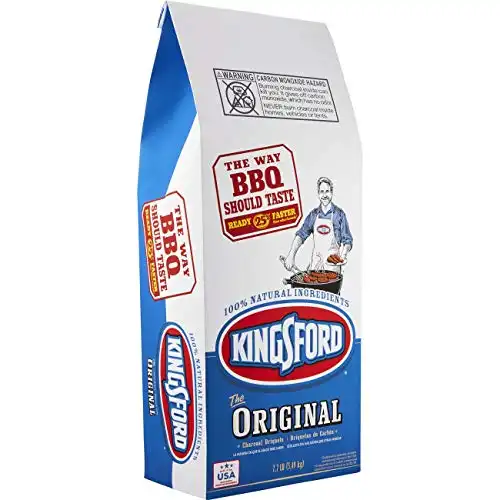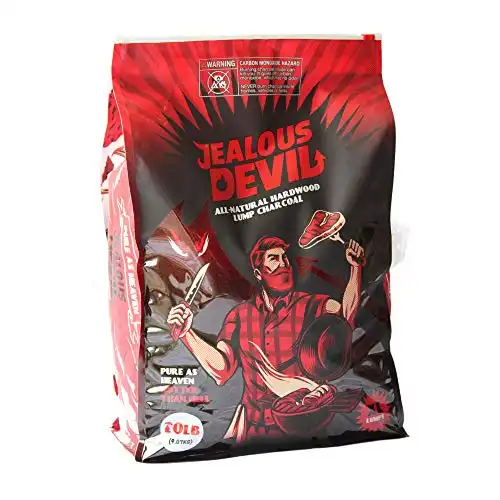Lump Charcoal vs Briquettes – What the Experts Say

There’s something about cooking and talking about barbecue that turns normal people into crazed zealots.
One of the most common questions debated over and over again is whether to use lump charcoal or briquettes.
We’ve turned to the experts to weigh up the pros and cons of cooking with lump charcoal vs charcoal briquettes.
If you’re new to cooking with charcoal and haven’t come across the Charcoal vs. Briquettes debate, then don’t worry. We’ll run through the differences between each fuel source.
Read on to understand exactly which type of fuel is best for your situation.
What’s all the fuss about Lump Charcoal?
Lump charcoal is made by slowly burning pieces of wood in the absence of oxygen until all the natural chemicals, sap and moisture get out of the wood.

After that we are left with less harmful charcoal lump with lots of good qualities; it is little more than carbon, leaves very little ash after burning out, burns hotter and lights faster than briquettes.
Lump charcoal also responds accordingly to oxygen, hence you can easily control the level of heat if your grill features adjustable air vents.
It also contains no fillers or additives which makes it one of the cleanest ways to barbecue. A great choice for cooking steak caveman style directly over the coals.
Lump charcoal burns faster and hotter than briquettes so you do need to be careful with your temperature control.
Lump Charcoal Pros:
- Contains no additives (all natural)
- Easier temperature adjustment
- Little ash production
- Burns hotter
- Lights quickly
Lump Charcoal Cons:
- Bags contain uneven pieces of charcoal that can make it hard to grill. It also takes a bit more effort to cook with the snake method although it can be done by breaking the lump down into briquette sized chunks
- More expensive than briquettes
- Burns faster
Overview of Charcoal Briquettes
Briquettes are made from sawdust and leftover woods that are burnt down the same way as lump charcoal. Unlike lump charcoal, additives are in the process of making briquettes, unlike lump charcoal which is pure wood.

The additives are mainly used to hold the materials together in order to achieve clean little blocks that are often roundish-squarish in shape which makes them easier to stack.
Although briquettes burn longer, they do not burn as hot as lump charcoal.
They are sometimes made using chemicals or other lighter fluids to make starting easier. In most cases, you will end up tasting what you burn because of the additives used when making briquettes. ‘
Many briquette users have claimed to smell the additives as they cook and sometimes even taste it in lighter foods like chicken or fish.
But that shouldn’t discourage you from using briquettes so long as you stock up on a reputable brand like Kingsford (make sure you don’t get the easy lighting one).
Briquette Pros:
- It maintains a steady temperature for a longer period.
- Cheaper than lump charcoal.
- Burns longer.
Briquette Cons:
- Large ash production.
- Produces a chemical smell.
- Takes longer to light.
If you’re researching to decide if you want to try cooking with charcoal, we have a guide to the best charcoal smokers and best charcoal grills available.
Lump charcoal vs briquettes – what do the experts say?
Most experts with an opinion on the matter can relate that each of the two choices come with their advantages and disadvantages.
So let’s hear what the experts had to say about the pros of using either lump charcoal or briquettes.

Meathead Goldwyn, The Great Charcoal Debate
“Lump charcoal is superior amongst its users because of its purity – it contains no lighter fluids like instant-light briquettes or additives like regular ones.
The reason why many people go for charcoal lump is because it reflects on their desire to have less additives or chemicals taste in their cooking and their food.
I see lump charcoal as an extension of the organic movement”
Meathead goes on to point out that claims of chemicals affecting the taste of your food are overblown.
“There is no sufficient evidence that the additives in briquettes cause much impact on the food that one is cooking,”
Meathead Goldwyn – The Great Charcoal Debate: Briquettes Or Lumps?
For instance, Kingsford, the largest producer of charcoal in the U.S., rarely talk about what their briquettes include.
But on their website, they mention that they use cornstarch, borax, limestone, and coal.
Jeff Allen, executive director of the National Barbecue Association, says “I have seen a lot of experts who prefer the lump charcoal over briquettes, simply because charcoal can have a regional, cultural aspect.”
If you use lump charcoal made from pine, then it would burn fast and hot — and it is awesome for searing a steak,” says Allen.
But you can use charcoal made from wood with a higher density like hickory or oak if you want a slower cook.”
Not everyone is convinced though…
As much as charcoal or briquettes can be awesome for grilling various foods, they also come with their drawbacks. Here is what experts had to say against using lump charcoal.

Matt Duckor, Why I’m Over Using Lump Hardwood Charcoal
“I went out and bought a bag of lump hardwood charcoal, brought it home, and loaded up my chimney starter with the irregularly shaped shards of petrified-looking wood.
I immediately noticed just how hot the hardwood stuff got and, before I knew it, how quickly it burned out. Things get especially tricky if you’re aiming to use lump hardwood charcoal for the kind of grilling session that can stretch over a span of several hours.
Every time I used it I ended up frustrated and confused, feeling all alone in this brave, overheated new grilling world.”
While Matt makes some good points, we think you can still control the heat with care and practice.
Jeff Allen from the National Barbecue Association points out that “charcoal generates more smoke than briquettes, which could be a problem with strict rules like apartments, retirement communities or even condos.”
Where to buy and best lump charcoal brands
Well, I am sure there are some of us who are wondering where to get the best charcoal brands for a successful charcoal barbecue.
Truth be told, there are many charcoal brands out there in the market but choosing the best brand can sometimes be confusing.
If you really want to obsess over it, the great people over at The Naked Whiz maintain an incredibly detailed charcoal review database.
If spending hours reading charcoal reviews doesn’t sound like your cup of tea, then the hardwood lump charcoal from Jealous Devil is a popular choice.
It produces low ash, excellent heat, lights fast and the chunks aren’t too big.
We’ve had both good and bad experiences with some of the lump charcoal available in the market.
Rockwood, Fogo and Royal Oak are also solid choices.
There seems to be a lot of variance in the level of quality, size and ash produced.
Resources to help you determine whether to use lump charcoal or briquettes
Grilling Smackdown: Lump Charcoal vs. Briquettes — In depth guide to choosing lump charcoal or briquettes.
Charcoal fuel types –
The Great Charcoal Debate: Briquettes Or Lumps? – An article that provides relevant information on the great charcoal debate: Briquettes or Lumps?
Lesson 8: Lump vs. Briquette Charcoal – An episode by Fred Thompson that deep dives into the debate.
That brings us to the end of this article regarding lump charcoal vs. briquettes. I hope that you will find useful information to help you choose wisely.
And if you are also confused about how much charcoal to use, we’ve got you covered in our separate post on the subject.










